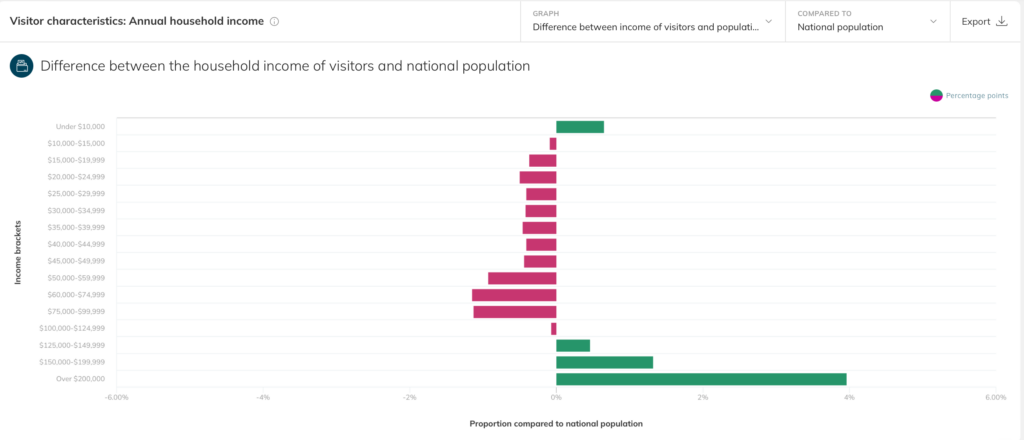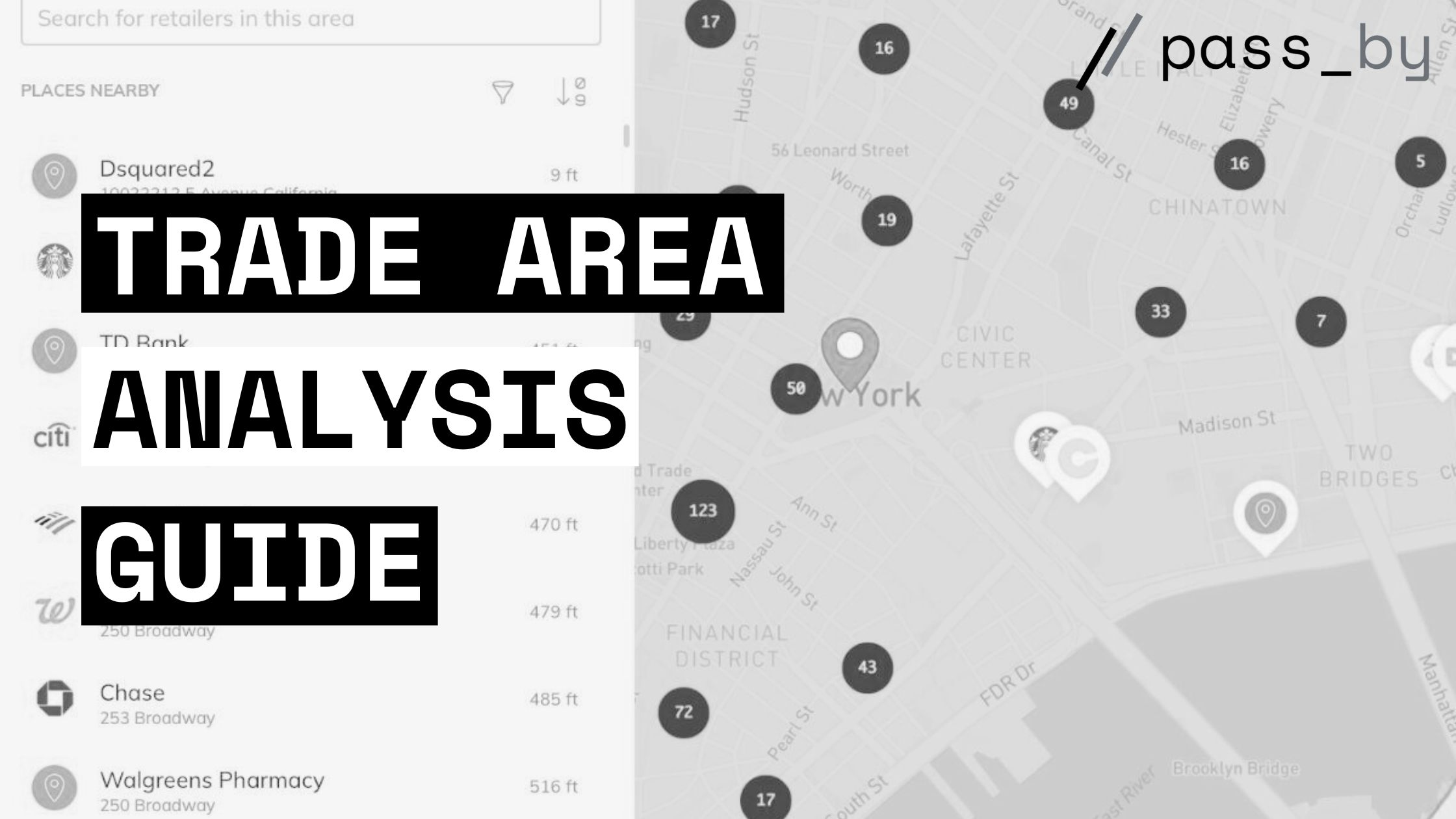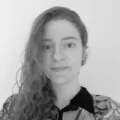Trade area analysis is a crucial concept in the world of retail and service provision. At its core, it involves looking at the geographic area from which a business draws its customers. This analysis helps businesses understand where their customers come from, how they interact with the business, and even what factors drive them to choose one store over another.
At pass_by, we offer the highest in market accuracy with 94% correlation to ground truth, over 15 data inputs, and a full 90 days of predictive feeds. Book a call now.
Here’s everything you need to know about trade area analysis:
What is meant by trade area?
A trade area means the location where customers live and the distance they could travel to another location. Trade areas are made using a map and calculated using data. Distances, Points-of-Interest, highways, and public transport links, are all useful when defining a trade area.
“No community has a single trade area. In reality, each individual business has its own trade area,” Ryan Pesch and Bill Ryan, University of Wisconsin-Madison.
What is trade area analysis?
Trade area analysis is the process of studying the geographic area around a business to understand its customers. This includes factors like consumer demographics, spending habits, and competitors.
By understanding the trade area, professionals can make better decisions about things like business expansion, marketing, inventory, etc.
Trade area analysis is used in the retail industry, by urban planners, and by commercial real estate developers and investors.

What are the three main factors of a trade area analysis?
The three main factors of a trade area analysis are:
- Economic state of the area: Income levels, disposable income, etc.
- Competition level: Distance from nearest competitor, number of competitors in the area, and how well they are performing.
- Unique characteristics: No area is the same. Unique characteristics can include population levels, distance to the nearest attraction, and local amenities.
How many types of trade area analysis are there?
There are many methods and techniques to conduct an analysis. The three main types of trade area analysis are:
- Drive-time analysis: Based on travel times and road networks, drive-time analysis shows how long it takes for consumers to drive to your location. The analysis is often illustrated on a map, displaying the 5-15 minute journeys consumers could take.
- Gravity models: The probability of a customer visiting your business. The gravity model is often displayed on a map, showing the highest to lowest probabilities similar to a heat map.
- Radial studies: A radius created by drawing rings of varying sizes around the business location. One of the most affordable methods, but the most imprecise and outdated.
Each type of analysis offers something different. However, doing a trade area analysis with aggregated, anonymized consumer data and foot traffic data has many more advantages. This makes the analysis far more accurate and actionable.
Trade area analysis: step-by-step example
Before you conduct your analysis, it can be helpful to see some examples of what one may look like. Here’s our example to illustrate what a trade area analysis means and how to do it.
Step 1: Define the market area
Once you’ve identified your location, your first step is to define the Total Market Size of the area. This estimation is calculated using the total population of the area’s immediate location, followed by the surrounding area, and the area within a reasonable distance. This is the first step of the Huff Model, a tried and true method in trade area analysis.
While you can do this yourself, many data platforms can do it for you or make it easier by providing the data.
Step 2: Area analysis
Whether you’re analyzing your current store or considering a new location, the next step of trade area analysis is to analyze your location with business intelligence. To do this, we’re using a data platform to produce reports for us as this is the most efficient method.
In area analysis, you should aim to answer these questions:
- What are the busiest zip codes in this region? Is my location benefitting from any foot traffic in the area?
- What are the busiest stores, where are they, and what are they selling? Is there enough demand for my business?
- What chains are performing best in this area and which ones are struggling?
- How far are my nearest competitors?
- Where are the nearest transport links or parking lots to my business?
Once you’ve gathered information on the area, you can start to hone in on the smaller details.
Step 3: Consumer analysis
A critical part of trade area analysis is understanding your consumers; this can be done using psychographic and demographic data.
For example, you can typically split consumers into three main types when analyzing an area:
- Local: Nearby customers could be those who live or work in the area. These customers are likely looking to buy food, gas, and other essentials.
- Distant: Customers willing to travel into an area are more likely to be looking to purchase specialty items, heavy goods (i.e. Furniture), or a vehicle.
- Tourists: These visitors are in the area for a specific attraction or event, but can and do shop while they’re in the area.
But these major types can only tell you so much. The aim of trade area analysis is to gather more information to help you make a decision and create customer segments.
Here’s one example of consumer analysis using the data platform Almanac. Here, the platform shows you the annual household income of visitors to your location. This can help you adjust expectations, marketing materials, and strategies moving forward.

Other factors considered in consumer analysis include age range, visit share, commute type, education levels, homeownership, annual household income, and work industries.
All of this information is anonymized, aggregated and available through our data platform. Book a call with our team for a demo.
Step 4: Store analysis
Once your business is open, trade area analysis can help to optimize using information gathered from previous steps. For example, you can use consumer data to adjust opening hours, sales, prices, product placement, partnerships with other businesses, and inventory.
See our case studies to find out how businesses are using our data to optimize.
Why is trade area analysis important?
Knowing your trade area is crucial as it helps you measure the number of potential customers, how much they have to spend, and the competitors that could stand in your way.
Without trade area analysis, you risk misunderstanding your customer base and you could even open a new store in a suboptimal location.
Benefits of trade area analysis
The benefits of implementing trade area analysis in your business planning can be substantial and far-reaching. These benefits include:
- Informed site selection
- Competitive intelligence
- Local trends
- Strategies for growth
1. Informed site selection
First and foremost, trade area analysis contributes to Informed site selection. By assessing the demographics, purchasing power, and competition in a specific area, you can make an informed decision on the most advantageous locations for your business. This can notably influence your operations’ success and cost-effectiveness.
2. Competitive intelligence
An analysis equips you with competitive intelligence. You’ll gain insights into the strength of your competitors, their location strategies, customer base, and how well they meet market needs. This clarity allows your business to craft better strategies that provide a competitive edge in the market.
3. Local trends
The third benefit revolves around the identification of local trends and opportunities. Understanding your trade area gives you an insight into local consumer behavior and trends, helping you align your goods or services with the prevailing market requirements. This results in improved customer satisfaction and enhanced business prospects.
4. Strategies for growth
Finally, trade area analysis allows you to strategize for growth. It presents a comprehensive picture of your business’ potential in various locations. This makes it an indispensable tool for planning expansions or exploring fresh markets.
Remember, your trade area is more than just a geographical location—it’s a well of data that, when properly analyzed, can lead to significant improvements in your strategic planning and business outcomes.
Factors to consider in trade area analysis
When completing your analysis, there are many factors you will need to consider. Chief among these are:
- Site selection: Analyze an area from many angles to select an optimal location for your business. See our guide to site selection for a step-by-step guide to the process.
- Competition: Location data can help you find the number of competitors in your trade area and analyze their performance. You could discover a gap in the market during your analysis.
- Inventory management: When you understand the demand patterns in your trade areas, you can enhance your inventory planning accordingly. This means knowing what products to keep in more quantities, which ones to cut back on, and at what time. This preemptive approach saves both time and resources, leading to increased efficiency and profitability.
- Marketing: Target marketing means developing targeted strategies for a higher conversion rate by analyzing consumers in your customer base. This can lead to adding or changing your brand’s app notifications, sales alerts, social media posts, paid advertising, etc.
- Consumer demand: Is there enough demand in the area for your business? If an area you’re considering already has multiple businesses similar to yours, then demand may be low. It’s best to use trade analysis to look for gaps in the market and opportunities.
- Attractions: A community or leisure attraction (e.g. a theme park) can offer more opportunities in your trade area as these attractions can pull in more consumers from a longer distance and a higher number of visitors consistently.
- Population density: In general, the larger the population, the bigger the trade area.
- Business mix: An area with a multitude of business types, for example one with a gym, hotel, office, school, restaurant, clothing store, bank, is better than one with a limited mix. A large mix offers various types of consumers.
How to conduct a trade area analysis
To conduct an accurate trade area analysis, you will need to choose a method such as drive-time analysis, gravity models, radial method, foot traffic data, or a combination of multiple methods.
Foot traffic data using ground-verified, anonymized and aggregated consumer visits offers the most accurate data to begin your analysis.
At pass_by, we offer the highest in market accuracy with 94% correlation to ground truth, over 15 data inputs, and a full 90 days of predictive feeds. Book a call now.
Trade area analysis FAQs
Do online businesses use trade area analysis?
Yes. Trade area analysis isn’t just for brick-and-mortar retail. Online businesses can identify, analyze and learn from brick-and-mortar competitors using trade area analysis. Online businesses can use the analysis to identify locations where their consumers are based and use this information to adjust marketing strategies, set up partnerships with other businesses, and consider a pop-up shop.
What is the most important trading area to a retailer?
The most important trading area to a retailer is the primary retail trade area. This area can generate anywhere from 50 – 80% of all sales in-store. This area has the most frequent recurring visitors, often consisting of locals and workers in the area.





